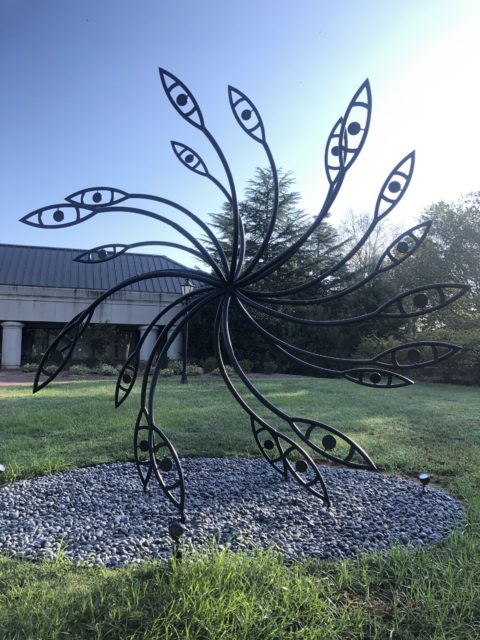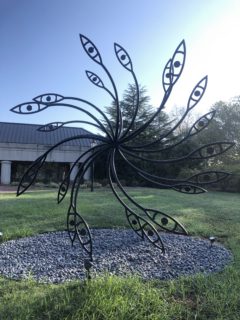Upon returning to campus in August, Davidson students were welcomed by a new addition to the campus’s collection of outdoor art – the painted steel sculpture titled Walking See Flower (2001) by Texan artist James Surls. Even I, as an art history major and gallery intern, was surprised by its presence outside of commons, as it disrupted such a familiar Davidson landscape. Because it is in a high-traffic area of campus, this piece now holds a place in campus conversation by posing two questions: what role should art play on a college campus, and how do landscape, both built and natural, interact with neighboring sculptures?
Before going into those questions, it is important to understand Surl’s background. He was born in Terrell, TX and attended both the Sam Houston State Teachers College and the Cranbrook Academy of Art in Michigan. After teaching at Southern Methodist University in Dallas for 20 years, he now lives and works in Carbondale, CO as an active member of the contemporary art community. His work is exhibited in major museums both nationally and internationally, such as the Smithsonian American Art Museum, LACMA, the Guggenheim, Whitney, and major museums in Mexico and Singapore.
He has a sense of consistency in the work he produces, both in subject matter and materials. He uses a combination of natural forms, like branches and leaves, with wildly different materials such as steel and wood for his sculptures. Simultaneously, he plays with scale and the interaction between the viewer and the sculpture, both in indoor and outdoor settings.
In our own Walking See Flower of 2001, the repeated motifs of the eye, the leaf, and the branch are instantly recognizable. Further, there is a play with scale that makes the natural forms more imposing over our human stature. It seems like nature is watching us, almost questioning us, with the repeating eyes/leaves staring us down as we walk by. Further, there is a sense of rapid movement despite the brittleness and unforgiving nature of the painted steel structure. In this way, Surls has added nuance and human complication to the seemingly simple world of nature. Though it initially looks like a flower, you can sense the human engagement and subsequent impact of our world onto this innocent piece of nature.
We have so many other pieces by prolific sculptors on campus, including Antony Gormley, Jaume Plensa, Magdalena Abakanowicz, Vivian Beer, the list goes on. However, the acquisition of this specific Surls piece gives a poignant combination of humanity and nature into a group of sculptures mainly focused on either one side or the other. In this way, this piece is a natural and important stepping stone for the future of sculpture on this campus, by nature of its duality of nature and humanity.
For those interested in looking at more work by Surls, it is worth engaging with his both his prints and his graphite drawings. They are essentially two-dimensional interpretations of the three-dimensional work he makes out of steel and wood. He is not just someone skilled in creating imposing works that intrude in our space, but also is successful in creating deeply meaningful and layered worlds on paper.


